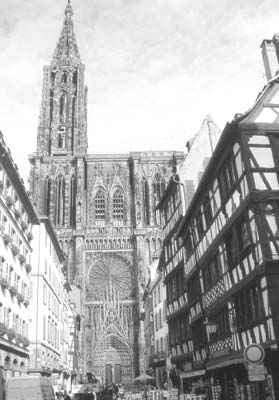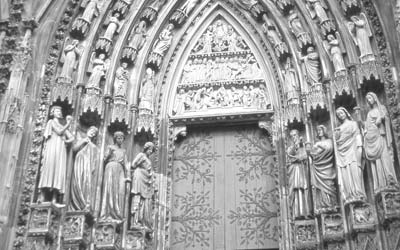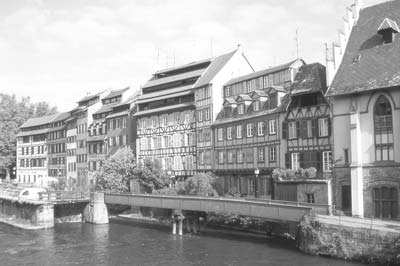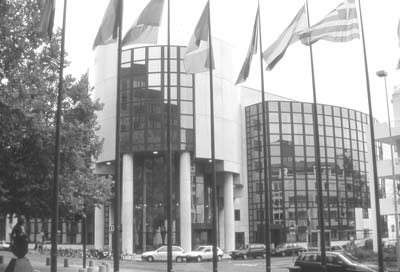Strolling through Strasbourg
by Beverly Shaver, El Cerrito, CA
Years of travel have taught my travel companion and me the value of a pause between segments of intensive touring. After a week of “Bags out at 7:00,” we find it wonderfully restorative to spend a quiet interval by ourselves in some interesting city, easily sandwiched into our itinerary.
And so, after a 9-day tour through western Germany in October ’02, we scheduled ourselves a week’s time-out before embarking in Amsterdam on a river cruise through Holland and Belgium.
Our tour had ended in Würzburg, Germany, from where it was a 7-hour train trip ($71 each in second class) via Frankfurt to that French historic gem, Strasbourg. It being the headquarters of the Council of Europe and the seat of the European Parliament, we knew this to be a prestigious city, one which has kept its small-town charm and a reputation as a stroller’s paradise with history discovered at every corner.
This was a place where the word “terrorist” was almost unknown, a place Germans refer to as gemütlich (comfortable and pleasant). Yet it’s a city rich in art, music and the intellectual ambiance of a renowned 4-centuries-old university.
Getting settled
Emerging from Strasbourg’s main railway station in an early evening drizzle, we put on our ponchos and wheeled our small bags across a vast plaza to the Place de la Gare, a crescent lined with upscale hotels. We tried several which were too expensive for our budget. Then, at the sedate Bristol, a well-tailored concierge gave us a card for a budget hotel a short block away.
The 2-star Hôtel le Grillon (2 rue Thiergarten; fax 33 3 88 32 22 01 or visit www.grillon.com) was picturesque, with paper flowers and worn carpeting but wood surfaces that shone and brasses that gleamed. We booked into a spacious, quiet room on an upper floor (no elevator) with oak plank floors, a hooked rug, chintz coverlets and a dormer window. The tab was a modest $30 per night, sans breakfast.
Just up the street, next to the tabac, was the cheerful little Café de la Criller, where we established a week-long connection with locals over steaming café au lait and warm croissants ($3 each).
A mix of cultures
Perhaps because of its out-of-the-way location, at the very eastern edge of France and just across the Rhine River from western Germany, Strasbourg has been relatively undiscovered by Americans. Part of Germany for almost half a century and subsequently occupied by Germans during WWII, it has an intriguingly bicultural society with most of its citizens speaking both French and German as well as the local Alsatian dialect.
Our newly made friends at the café and hotel were graciously tolerant of our pidgin French and outdid one another in advice, guidance and tourist tips. The barber and his wife produced a glossy booklet in English, “Strolling in Strasbourg” ($4 at all the city’s tourist offices). They stood over us, ready to instruct, as we examined the five suggested itineraries, each with a clearly detailed map.
What bliss it turned out to be, sauntering at our own pace through the narrow, crooked, pedestrian-only streets ribboned with canals and the windings of the River Ill.
There was a sense of being in a live-in museum as we spent enthralled hours in the Petite France quarter, formerly occupied by fishermen, millers and tanners. There were postcard-perfect gabled Renaissance houses reflected in the green river waters along with flocks of swans, plus barges each waiting their turn at the river locks.
We picnicked beside the Vauban Dam, built in the 17th century as a floodgate. From there we enjoyed a panorama of the legendary Ponts Couverts, comprising three stone bridges and four towers at the dividing point of the Ill, vestiges of the city’s early fortifications.
By boat and by train
On a sparkling afternoon, we succumbed to our hotel manager’s touting of a 75-minute excursion on the Ill by glass-canopied barge (departures available every half hour from the Palais des Rohan, at $6 each). The boat was full of chattering Germans and Belgians, but the host added English for our benefit in pointing out the sights.
The trip was such a pleasure that we told our manager we would take his further advice regarding the 45-minute Mini Train ride around the Old Town ($5 each). Exposed to the whole town as sheepish tourists in the little train’s open cars, we unabashedly craned our necks to view the 16th- to 18th-century houses and courtyards, decorated with plaster lions and ferocious faces to scare away the devil, plus orioles, wooden galleries and loggias.
The steeply sloped tiled roofs were punctuated with dormer windows, providing air circulation and a form of refrigeration for householders who stored hams and cheeses in their attics.
The cathedral
It was on our second day that we discovered, a short walk from the Grillon, the physical and emotional heart of Strasbourg and one of Europe’s most striking examples of Gothic architecture: the Cathedral of Notre Dame. When completed in 1439, the lacy, open-work spire made it the tallest building in Christendom (466 feet).
Here was a stunningly decorated façade with masterpieces of sculpture and, inside, some of the most marvelous stained glass in all of Europe.
We kept returning to it, making new discoveries each time and hurrying at half past noon to the clock portal in the cathedral’s south transept, where a few euros’ admission charge allowed us to witness the amazing performance of the 16th-century astronomical clock. When a small cherub struck the time at 12:31, another cherub turned over an hourglass, an old man passed before Death, the 12 apostles paraded before Christ and the cock above flapped its wings, crowing three times.
We agreed not to tell our children that we went twice to watch this mechanical wonder lurch through its awesome message about time, life and death. We would tell them instead about the memorable evening when we sat in the illuminated cathedral nave and shivered ecstatically as the great organ swelled in a Bach toccata.
The European Quarter
While the dazzling array of museums took up much of our week — the Cathedral Museum with many of the cathedral’s original statues; the Rohan Palace and Prince-Bishop’s staterooms, considered the finest French interiors of the 18th century; the Fine Arts Museum, known for its Italian and Spanish masters; the Archaeological Museum, with displays on prehistory and extinct animals, and the Decorative Arts Museum, which tells the story of the city’s crafts and craftsmen with one of the finest ceramics collections in France — the highlight of the week was the day we spent at the European Quarter.
We took the No. 23 municipal bus to the lush, green campus in north Strasbourg that represents the vision of a united, cooperating community of democratic European nations. Behind a phalanx of brilliantly colored national flags sit the striking modern buildings that house the multination Council of Europe, the European Parliament and the European Court of Human Rights.
The Palais de l’Europe is a monumental quadrilateral structure with distinctive sloping facades. Inside is a vast amphitheater in which the meetings of the Council of Europe (including over 40 member states) take place as well as those of the Assembly of the 15 member states of the European Union.
We had guided visits around the campus and watched films about the work of all these bodies, then paused for lunch in the Palais’ cafeteria, where many earnest people in suits talked animatedly in a babble of languages. (Free public tours are available Monday to Friday, outside of Parliamentary sessions. Prior booking is necessary. For information and reservations, phone 03 88 17 20 07.)
Our departure on the seventh day was made reluctantly. This lovely city had become deeply familiar, its atmosphere and spirit imprinted on our minds and hearts. The friends we had made presented us with a carefully wrapped tarte flambé (a kind of French pizza) and a bottle of the piquant Tokay d’Alsace for snacking on our train trip to Amsterdam. We were rested and keen for our upcoming cruise through Holland and Belgium.





